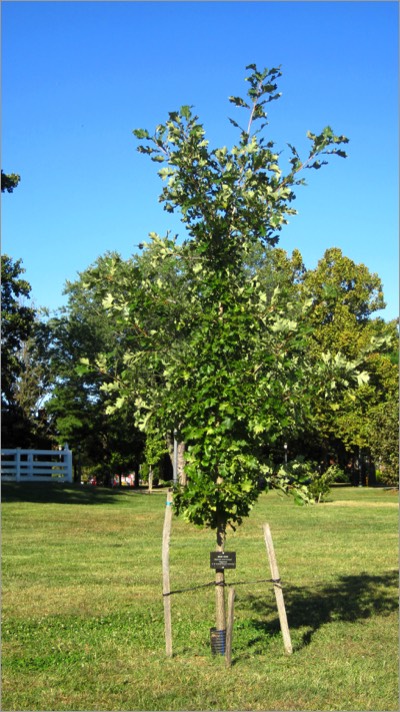**Bur oak

**Quercus macrocarpa
BUR OAK
Fagaceae
E. & Central North America
Location: map coordinates U-16 (south of Loockerman Hall), N 39°11'5'' W 75°32'41''
Planting history: planted 5/6/10. Source: Delaware Nature Society. (Dr. S. Yost, USDA NIFA Capacity Building Grant funds).
Description:
**Adventive species (not native to Delaware, but native to N. America and now growing wild in Delaware) in New Castle County piedmont
BUR OAK
Fagaceae
E. & Central North America
Location: map coordinates U-16 (south of Loockerman Hall), N 39°11'5'' W 75°32'41''
Planting history: planted 5/6/10. Source: Delaware Nature Society. (Dr. S. Yost, USDA NIFA Capacity Building Grant funds).
Description:
- large deciduous tree; one of the most massive oaks
- etymology: Quercus = the Latin name; macrocarpa = large-fruited
- also called mossycup oak
- leaves simple, alternate, lobed; wider at top, with shallower lobes, than the basal part of the leaf (usually divided in the middle with a “waist”); leathery, shiny above
- monoecious (separate male and female flowers on same tree); flowers tiny; male flowers in drooping catkins, female flowers inconspicuous
- fruit is an acorn (develops from ovary of female flower); said to be the largest acorn in N. America, cup ca 1”-2” wide (hence the scientific name “macrocarpa”); cup large with fringe at edge (hence also known as mossycup oak)
- in the “white oak group”: leaf lobes rounded; acorn matures in 1 year, often relatively sweet and edible
- end buds clustered (typical of oaks)
- good ornamental; tolerant of urban conditions
- native habitat is open areas, like prairies; from Canada south to Virginia
- cultivated species, escaping to fields in Delaware
**Adventive species (not native to Delaware, but native to N. America and now growing wild in Delaware) in New Castle County piedmont


HIT REFRESH TO START LOCATION GRAPHIC